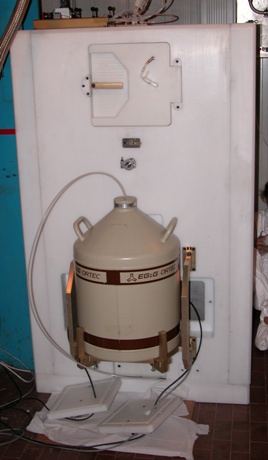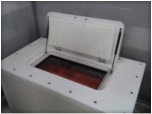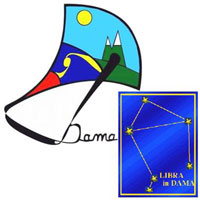The main radiopure experimental set-ups of the DAMA project at LNGS are:
 |
 the DAMA/NaI set-up (~100 kg highly radiopure NaI(Tl)), which has completed its data
taking in July 2002. It had as main aim the investigation of the presence of a Dark
Matter particle component in the galactic halo by means of the model independent
annual modulation signature. With the 0.29 ton x year total exposure it achieved
a 6.3 sigma C.L. model independent evidence [1], [2]. Some of the many possible corollary quests for the candidate particle have also been carried out [1], [2], [3], [4], [5], [6], [7], [8]. The same experimental set-up has also obtained several other results on other
approaches and on various other rare processes (e.g. solar axion, possible
Pauli exclusion principle violation, cluster decay, possible spontaneous transition
on nuclei to a superdense state, Q-balls, possible charge non conserving processes,
SIMPs and nuclearities, electron stability). |
 |
 the DAMA/LXe set-up (~6.5 kg liquid Xenon), which can take data filled with Kr-free Xenon enriched either in 129Xe or in 136Xe isotopes.
It has investigated several rare processes with time passing in the various
configurations and is in operation. The main experimental results
have been obtained investigating e.g.: dark matter with various approaches,
double beta decay in 134Xe and in 136Xe,
possible charge non conserving processes,
electron stability, possible nucleon,
di-nucleon and tri-nucleon decay into invisible channels. the DAMA/LXe set-up (~6.5 kg liquid Xenon), which can take data filled with Kr-free Xenon enriched either in 129Xe or in 136Xe isotopes.
It has investigated several rare processes with time passing in the various
configurations and is in operation. The main experimental results
have been obtained investigating e.g.: dark matter with various approaches,
double beta decay in 134Xe and in 136Xe,
possible charge non conserving processes,
electron stability, possible nucleon,
di-nucleon and tri-nucleon decay into invisible channels. |
 |
 the DAMA/R&D set-up, where tests of prototype PMTs and detectors are carried out
as well as small scale experiments mainly devoted to the search for double beta
decay processes in various isotopes (e.g. 40Ca, 46Ca, 48Ca, 64Zn,
70Zn, 180W, 186W,
106Cd, 108Cd, 114Cd, 136Ce, 138Ce,
142Ce, 130Ba); other rare processes have been also
studied, we recall e.g.: dark matter with CaF2 crystal scintillator, rare alpha
decay in 151Eu, rare beta decay of 113Cd. Many other measurements
are in progress/preparation. the DAMA/R&D set-up, where tests of prototype PMTs and detectors are carried out
as well as small scale experiments mainly devoted to the search for double beta
decay processes in various isotopes (e.g. 40Ca, 46Ca, 48Ca, 64Zn,
70Zn, 180W, 186W,
106Cd, 108Cd, 114Cd, 136Ce, 138Ce,
142Ce, 130Ba); other rare processes have been also
studied, we recall e.g.: dark matter with CaF2 crystal scintillator, rare alpha
decay in 151Eu, rare beta decay of 113Cd. Many other measurements
are in progress/preparation. |
 |
 the second generation DAMA/LIBRA set-up (Large sodium Iodide Bulk for RAre processes; ~250 kg more radiopure
NaI(Tl)) is continuing the investigations of DAMA/NaI with a larger mass and an increased sensitivity. In
particular the data of the first four annual cycles (exposure: 0.53 kg x year) have been
released in 2008. The results confirm the model independent
evidence for the presence of Dark Matter particle in the galactic halo [1], [2]. In February 2010 the data of two
further annual cycles have been released [3]
and in 2013 [4] the cumulative model independent result of DAMA/LIBRA-phase1 has been
released by adding an additional annual cycle. The cumulative exposure collected, considering the 7 annual cycles of DAMA/NaI and
the 7 annual cycles of DAMA/LIBRA-phase1, is 1.33 ton x year. The
model independent evidence is observed with a statistical significance of 9.3 sigma C.L..
This model independent result is compatible with various Dark Matter candidate particles, interaction types
and scenarios. No experiment whose results can be directly compared in a
model independent way with these ones is available in the field. |
 |
 The DAMA/Ge set-up dedicated to measurements on samples' radiopurity
and on relatively small scale experiments, is operative at the LNGS STELLA facility;
is has obtained several interesting results on rare processes. It is continuosly in operation
and many new measurements are in preparation.
|
 |
 The DAMA/CRYS set-up is a new small scale facility mainly dedicated to the
characterization of new prototype detectors.
|
Finally a 3-rd generation R&D
toward the creation of a possible 1 ton NaI(Tl) set-up,
proposed already in 1996, is in progress.
Some photos of the experimental setup:






